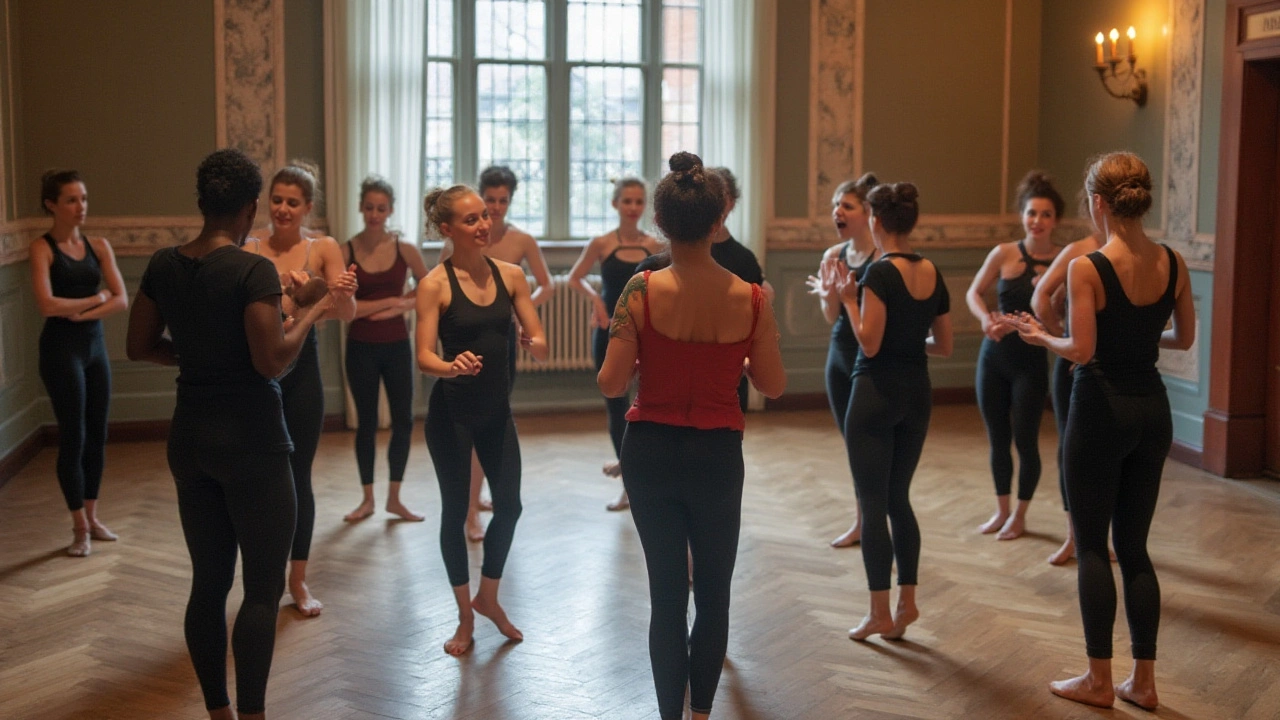Mastering Fascia Stretching Techniques for Dancers

For dancers, staying nimble and injury-free is as essential as perfecting steps and routines. Fascia, the connective tissue that weaves through and surrounds our muscles, plays a crucial role in a dancer's flexibility and movement capabilities.
Though often overlooked, this network can significantly impact performance if restricted or not taken care of. Learning the art of fascia stretching can unlock a dancer's full potential, offering enhanced flexibility and strength while minimizing the risk of injuries. This guide reveals how to integrate these techniques into your daily routine, ensuring you dance with ease and grace.
- Understanding Fascia and Its Role
- Benefits of Fascia Stretching for Dancers
- Techniques and Exercises
- Tips for Safe and Effective Stretching
Understanding Fascia and Its Role
Fascia is often described as the body's silent workhorse, a vast and intricate network of connective tissue that envelopes and connects all muscles, organs, and nerves. Yet it's surprising how little attention it receives compared to muscles and bones, especially when considering its extensive influence over physical performance. Acting much like a web, fascia provides the support and structure that permits our bodies to move with fluidity and grace, which is crucial for dancers who rely heavily on their body's ability to perform complex movements. Structurally, fascia is composed of multiple layers: the superficial fascia rests just beneath the skin, connecting it to underlying tissues, while the deep fascia envelops muscles and bones, guiding their movements and interactions. There's also the visceral fascia that surrounds organs, contributing to their alignment and functionality.
Scientific studies have shown that when fascia is healthy and well-maintained, it leads to improved flexibility and reduced pain, which can then reduce injury risk and optimize performance. When this connective tissue becomes tight or restricted, it can impair motion and create tension that can cascade into larger issues. One might think of it as a piece of fabric; when it's smooth and intact, movement is unrestricted, but when it’s bunched or taut, mobility is compromised. As clinical expert Dr. Robert Schleip once noted,
'The role of fascia in the coordination of movement is as important as the muscles themselves, often making it an unsung hero of human mobility.'Understanding and nurturing fascia is particularly crucial for dancers, who regularly put intense demands on their bodies, from leaps and falls to sudden directional changes. By grasping how fascia operates, dancers gain insight into managing their flexibility and strength, which is essential for optimal performance and injury prevention.
Historically, fascia was not well understood, being seen merely as biological filler rather than an active participant in body mechanics. However, the past few decades have shed light on its significance. Recent advancements in imaging technology have allowed scientists to observe fascia in action; studies utilizing MRI and ultrasound reveal how fascia layers glide over one another, demonstrating its undeniable role in facilitating movement. This newfound awareness has given rise to specialized training focusing on fascia stretching and care as a method to elevate a dancer's edge. When dancers engage with their fascia through targeted stretching and care, they often experience enhanced flexibility, developing a greater range of motion that allows for more expressive and unhindered performances.
For those still unconvinced about the importance of fascia, consider a study conducted by the Fascia Research Society, which highlighted that increased fascial pliability was directly correlated with a decrease in musculoskeletal injuries. Its results showed that regular attention to fascia could reduce the frequency of common dancer injuries by up to 20%. Such data strongly reinforce the notion that a dancer's wellness hinges significantly on maintaining fascia health. Incorporating fascia awareness into training regimens is not merely a precaution but a proactive approach to one's craft. By doing so, dancers can ensure they are not only performing to the best of their abilities but are also investing in their long-term wellness and career longevity. Understanding fascia is the first step toward harnessing its potential, inviting dancers of all levels to explore these connective tissues with curiosity and care.

Benefits of Fascia Stretching for Dancers
Many dancers strive to increase their flexibility to perform breathtaking moves, and fascia stretching can be a transformative part of this journey. Fascia stretches help in releasing tension in the connective tissues, leading to increased muscle elasticity and a broader range of motion. When you regularly practice fascia stretching, you're essentially giving your body the ability to move freely, reducing the feeling of stiffness that can sometimes impede your dance performance. Over time, these stretches can improve your balance and coordination, as muscle groups work more harmoniously together.
One remarkable benefit is the reduction in injury risk. Stiff fascia can lead to pesky injuries and prolonged recovery times. By focusing on stretching these connective tissues, dancers can better absorb and distribute physical stress throughout the body, minimizing the strain on muscles and joints. This preventive aspect is crucial, as even minor injuries can sideline a dancer, impacting both practice and performance schedules.
Fascia stretching can also lead to improved circulation. Fascia restrictions can hinder blood flow, making your muscles feel fatigued more quickly. By alleviating these restrictions, you boost circulation, ensuring your muscles receive the necessary oxygen and nutrients faster and more efficiently. This can help dancers recover quicker from strenuous rehearsals and performances, keeping them energized and ready to give their best on stage.
“Fascia fitness is the missing link in terms of movement efficiency and injury prevention,” says Dr. Robert Schleip, a leading researcher in fascia science. This powerful statement underscores the idea that attending to fascia health can enhance athletic longevity and performance.
Beyond physical advantages, there's a mental component too. Engaging in a routine that includes fascia stretching promotes mindfulness, as it encourages dancers to focus on their bodily sensations. This awareness not only helps in perfecting movements but also in recognizing any discomfort or imbalances early on, allowing for timely adjustments. Incorporating fascia work into your daily regimen can thus contribute significantly to your mental resilience and readiness in high-pressure environments.

Techniques and Exercises
Fascia stretching might seem like a niche or overly technical part of a dancer's routine, but it can be pivotal for achieving peak flexibility and preventing injuries. Often described as the 'secret weapon' in dance and athletic training, fascia stretching can improve the glide of muscles against each other, thus ensuring a more fluid movement. Dancers who incorporate these exercises regularly often find that their bodies respond quicker, recover more efficiently from strains, and indeed become more resilient to new challenges. Let's delve into some core techniques that can transform a dancer's practice.
One effective technique is the 'fascial release' using foam rollers or similar tools. Lie on the roller and gently move different parts of your body over it, focusing on areas that feel tight or restricted. This process is sometimes referred to as 'self-myofascial release' and works by breaking down knots and improving blood flow to tissues. Regularly spending about ten minutes on this technique can dramatically increase a dancer's range of motion. It's said that, 'A body in motion stays in motion when fascia is kept healthy,' as noted by renowned physiotherapist Dr. Linda Harrison. This quote emphasizes the necessity of keeping fascia flexible to maintain desired motion levels.
A staple of fascia stretching is dynamic stretching, which involves active movements that help to warm up and stretch the fascia. Examples include leg swings, arm circles, or spinal twists. These exercises are a great warm-up, mimicking the movements of your dance routine, thus preparing the fascia for more extended activity. Performing these stretches engages even dormant muscle fibers, enhancing their elasticity and readiness to move with more freedom. Research shows that dancers who practice dynamic stretching before routines show better performance metrics and have reduced injury rates. Ensuring your stretches target areas like hips, shoulders, and ankles — crucial pivot points — maximizes the benefits.
Another important technique is static stretching post-performance or training. Holding poses like the seated forward bend or butterfly stretch helps elongate and align the fascia after they have been thoroughly worked. Consider incorporating the use of props, like yoga blocks or straps, to deepen stretches safely. Hold these poses for at least twenty to thirty seconds to truly allow the fascia to release tension and steadily improve flexibility. This type of stretching allows the fascia to return to a relaxed state, facilitating repair and growth. Dancers who regularly stretch their fascia post-training often report reduced soreness and faster recovery times.
Integrating these fascia stretching exercises into a dancer’s regimen is invaluable for both performance and health. A structured routine combining foam rolling, dynamic stretches, and static post-dance relaxation can yield dramatic improvements. Consistent fascia care ensures not only agility and grace on the dance floor but a more sustainable, injury-free career. Remember, as the dancer's discipline improves, so does their trust in their body to perform timelessly and beautifully.

Tips for Safe and Effective Stretching
Stretching is an integral aspect of a dancer's routine, serving not just as a warm-up or cool-down activity but also as a means to enhance flexibility and prevent injuries. To stretch your fascia effectively, you must approach it with care and precision. The first and foremost tip is to be patient with your body. Stretching is not a race but a journey that should respect your body's current state and limitations. When starting out, ensure you are in a relaxed environment, free from distractions, where you can truly focus on your moves. Lighting and ambiance can play subtle roles in aiding relaxation, allowing your body to enter a state conducive to stretching. Many dancers find soft music helpful in establishing a calming mood, which enhances concentration on the subtleties of each stretch.
Another significant tip is to maintain consistency. Sporadic stretching sessions yield minimal benefits as the fascia needs regular attention to stay adaptable and healthy. Integrate stretching into your daily routine, perhaps as a morning ritual or a prelude to your nightly wind-down. Consistency helps in lengthening the connective tissues and gradually increasing your range of motion over time. Remember, your goal is to maintain balance between flexibility and strength, so vary your routines to keep them engaging and effective. As with any form of exercise, variety is key to preventing stagnation and monotony.
Correctly warming up your body is crucial before engaging in any stretching exercise. A mere five to ten minutes of light cardio such as jogging, dynamic dance moves, or brisk walking can help raise your body temperature and improve blood circulation. This preparatory stage primes your muscles and fascia for the deeper stretches to come, reducing the risk of injuries. It should not be overlooked or rushed through, as it sets the tone for the effectiveness of your stretch. Take these initial minutes seriously as an investment into the quality of your session.
When performing fascia stretching, breathe through each move. Controlled breathing is essential as it increases oxygen flow to the muscles and helps in managing discomfort. Deep, rhythmic breaths can assist in pushing past those moments of tension while maintaining safety. One might think of it as yoga for the connective tissues, where breath control plays a pivotal role in extending the boundaries of flexibility. Learning to synchronize your breaths with your movements can drastically enhance the quality of your stretches.
Avoid bouncing during stretches, as this can strain your muscles and lead to injury. Opt for slow, controlled movements instead, holding each position long enough to feel the stretch without overexertion. It is better to achieve small, sustainable gains rather than risk setbacks from trying too hard. Each body is unique, and comparing your progress to others could hinder rather than help. Listen to your body and celebrate your personal milestones.
If you're new to fascia stretching, or if something does not feel right, consult a professional. A licensed physiotherapist or an experienced dance instructor can provide personalized advice and correct your form. They can also tailor routines to fit your specific needs and goals while ensuring you maintain safe practices. In many cases, an external perspective can reveal unnoticed areas of improvement and refinement. This could make all the difference in efficiently achieving your stretching goals.
Incorporate assessments into your routine. Regularly evaluate your progress and adjust your stretches to match your growing flexibility. Developing an awareness of how your body moves and reacts can foster a more intimate understanding of your capabilities. Keeping a journal or log of your sessions might help track advancements, offering tangible evidence of your hard work and dedication.





